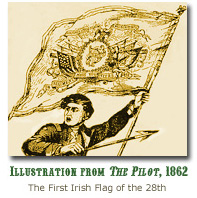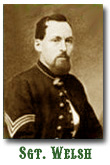Flags
of the 28th Massachusetts
 uring
the Civil War, each federal infantry regiment was generally issued two
flags: a state color and a national color.
uring
the Civil War, each federal infantry regiment was generally issued two
flags: a state color and a national color.
State colors typically had plain fields with
state seals positioned prominently in the center. In the first year of
the war, these flags came in a wide variety of colors and
non-regulation patterns. Some states instead issued copies of the dark
blue U.S. regimental flag, bearing an "army eagle" in the center, a
ribbon inscribed with the unit's designation in its beak.
National colors were the familiar stars and
stripes. They featured 34 stars early in the war, with additional stars
added as new states entered the union after 1863. The stars, often gold
in color, were positioned in a variety of ways on the blue canton,
sometimes surrounding a state seal. The regimental name was typically
printed in gold or white lettering along the fourth, or middle, red
stripe.
 Flags
were not just for show. They were vital field markers that readily
identified unit positions for men in the ranks and their officers, as
well as for aides carrying orders for brigade commanders. Without their
flags in sight, it would be easy for all of them to become disoriented
amidst the powder smoke and broken terrain, and fall out of formation.
Flags
were not just for show. They were vital field markers that readily
identified unit positions for men in the ranks and their officers, as
well as for aides carrying orders for brigade commanders. Without their
flags in sight, it would be easy for all of them to become disoriented
amidst the powder smoke and broken terrain, and fall out of formation.
Beyond their practical uses, flags boosted
regimental pride and morale. They were considered the very heart and
soul of the regiment itself. Presented as they so often were in the
context of a formal ceremony accompanied by patriotic speeches and
displays, flags symbolized the hopes and aspirations of the men, and
the cause they were fighting to uphold.
Carrying the colors was considered the
highest honor for enlisted men, since it meant entrusting the safety
and upkeep of these revered symbols to a select few. A regiment's two
flag bearers and color guard were carefully selected by the commanding
officer. Among the privileges they enjoyed was being excused from most
drill and fatigue duties when they were not engaged in battle.
 Being a
color bearer was also among the most dangerous of assignments, since
flags made inviting targets for enemy rifles and artillery. In the
thick of fighting, especially during a charge, those assigned to the
color guard were usually among the first to fall, and many are the
stories of brave men readily scooping regimental banners from the hands
of wounded comrades, only to be hit themselves just moments later.
Being a
color bearer was also among the most dangerous of assignments, since
flags made inviting targets for enemy rifles and artillery. In the
thick of fighting, especially during a charge, those assigned to the
color guard were usually among the first to fall, and many are the
stories of brave men readily scooping regimental banners from the hands
of wounded comrades, only to be hit themselves just moments later.
Two color sergeants of the 28th Massachusetts gave their lives bearing
regimental flags: Sgt. John J. McDonald, killed at James Island on June
16, 1862, and Sgt. Peter Welsh, mortally wounded at Spotsylvania on May
18, 1864. Another color sergeant, Henry Fraser, was seriously wounded
at Hatcher's Run on March 25, 1865.
Continued
>

